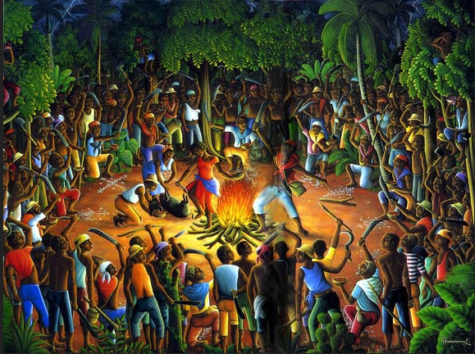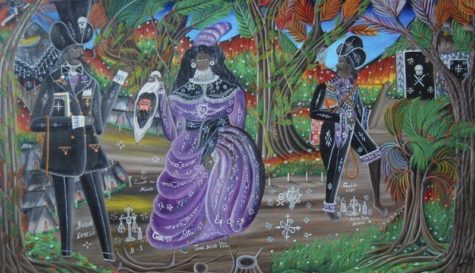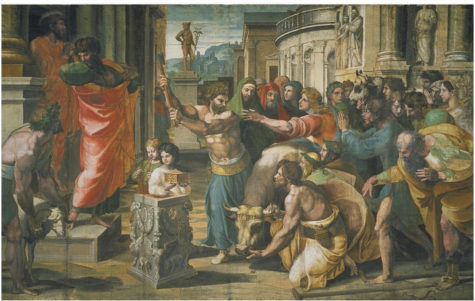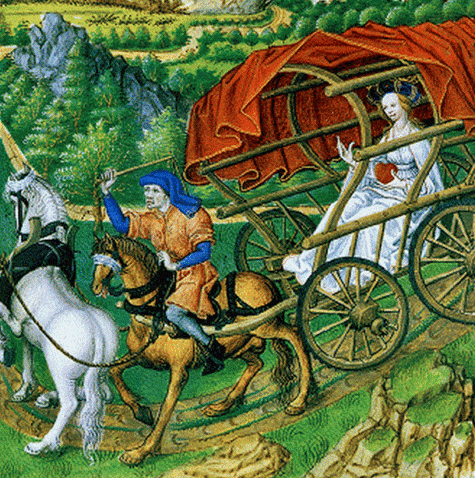Sacrifice
In Voodoo, Voudoo or Voodun, Mange Loa is the feeding of the Loa (Gods). This refers to a large annual feasting of all the Loa during which they are offered drinks, syrups, cakes, birds, chickens and even bulls. Other names for this feast are “The Breaking of the Cakes” and “Jan Case Gateaux.” It is believed that the powers of all Loa increase at Earth level during these celebrations often held on January 2.
In this, the most frequently performed ritual in voodoo, food or animal sacrifices are offered up to the Loa. Literally, this is a “feeding of the Gods.” Each Loa has a taste for a particular food or drink, all the better to summon the Loa to the living world. When rituals are held outside, food and other offerings might be left at a crossroad or other place of significance
Strictly speaking, every voodoo ceremony at which offerings are presented – birds, a goat and chickens, even a bull, and always the accompanying offerings such as liquor or cakes – is a feeding of the Loa; an augmentation of their powers at earth level.
Today give offerings to your personal Loa or deity. This both gives strength and power to the Loa/deity and also strengthens the connections between you both.
Who are the Loa?
Loa (also spelled lwa) are the spirits of Haitian Vodou and Louisiana Voodoo. They are also referred to as “mystères” and “the invisibles” and are intermediaries between Bondye (from French Bon Dieu, meaning “good God”) —the Supreme Creator, who is distant from the world—and humanity.
Unlike saints or angels, however, they are not simply prayed to, they are served. They are each distinct beings with their own personal likes and dislikes, distinct sacred rhythms, songs, dances, ritual symbols, and special modes of service. Contrary to popular belief, the Loa are not deities in and of themselves; they are intermediaries for, and dependent on, the distant Bondye.
The Loa protect children from misfortune. In return the families must feed the Loa through periodic rituals in which food, drink and other gifts are offered to the spirits. Services are usually held at a sanctuary on family land.
Collected from various sources
The 23rd of August marks the Ancient Greek holiday of Nemesia, – the festival of the Goddess Nemesis – the Goddess of Fate, Revenge, and Divine Retribution. Blood sacrifices were traditional on this day.
- Note: According to some sources the Nemesia fell on August 21.
This purpose of this festival was to ‘avert the nemesis of the dead’ in order that they could steer away the suffering or punishment of the living.
The goddess Nemesia, very basically, is the Spirit of Retribution against one’s own arrogance before the gods. Because she had this dual-nature, being both fortune and retribution, the Cults would celebrate in her honor to make sure they did not face her fury and could indeed have the gifts of fortune bestowed upon them. In many cases, she was worshiped by generals and gladiators who would pray for strength in combat. But surely this was not all.
She was invoked against those whose hubris and arrogance got the better of them, and served as a force of divine reckoning. She also appears in both Greek and later Roman mythology as an avenging force protecting those who have been violently wronged by their lovers. During the Imperial period of Rome, Nemesis was adopted as a patroness of victorious generals, and of gladiators entering the arena.
The Cult of Nemesia was later associated with Fortuna in Imperial Rome, the cult of Nemesis-Fortuna, which honored Nemesis as the deliberate balance to the random chance of Fortuna’s selections.The all-powerful Nemesia-Fortuna was worshiped by the Freemen of Hadrian and was considered to have a dual-nature about her.
This dual-nature in Nemesia is something which seems to me symbolic of our human nature. We have this spirit of fortune but also this spirit of retribution within us. At least I do.
Sources: State of Information and Pagan Wiccan
This is the name given to two festivals held in ancient Boeotia, which was a part of Greece, in honor of the reconciliation of Hera and Zeus. The dates of these festivals are somewhat nebulous and varied from place to place and year to year. One source cites March 10th.
The story:
According to the myth, Hera and Zeus quarreled and Hera went away to Euboea and refused to return to his bed. To trick her into coming back and on the advice of Cithaeron, Zeus dressed up a carved oak-trunk to resemble a bride and let it be known that he planned to marry Plataea, the daughter of Asopus. Hera was so angry she tore the clothes from the statue, discovered the deception, and was so pleased that the two were reconciled.
The festivities:
The Lesser Daedala (Δαίδαλα μικρά) was held every four to six years. The people of Plataea went to an ancient oak grove and exposed pieces of cooked meat to ravens, attentively watching upon which tree any of the birds, after taking a piece of meat, would settle. Out of this tree they carved an image, and having it dressed as a bride, they set it on a bullock cart with a bridesmaid beside it. The image seems then to have been drawn to the bank of the river Asopus and back to the town, attended by a cheering crowd.
After fourteen of these cycles (approx.59 or 60 years), the Greater Daedala (Δαίδαλα μεγάλα) was held, and all Boeotia joined in the celebration. At its start one wooden figure was chosen from the many that had accumulated through the years and designated the “bride”. The wooden figure was prepared as a bride for a wedding, ritually bathed in the Asopus, adorned and raised on a wagon with an attendant. This wagon led a procession of wains carrying the accumulated daedala (all the other images that had been created over the years) up to the summit of Mount Kithairon, where a wooden sacrificial altar was erected out of square pieces of wood.
This was covered with a quantity of dry wood, and the towns, persons of rank, and other wealthy individuals, offered each a heifer to Hera and a bull to Zeus with plenty of wine and incense, while at the same time all of the daedala were placed upon the altar. For those who did not possess sufficient means, it was customary to offer small sheep, but all these offerings were immolated in a hecatomb in the same manner as those of the wealthier persons. The fire consumed both offerings and altar
An ancient account of myth behind the festival is related by Pausanias:
“Hera, they say, was for some reason or other angry with Zeus, and had retreated to Euboia. Zeus, failing to make her change her mind, visited Kithairon, at that time despot in Plataea, who surpassed all men for his cleverness. So he ordered Zeus to make an image of wood, and to carry it, wrapped up, in a bullock wagon, and to say that he was celebrating his marriage with Plataia, the daughter of Asopus. So Zeus followed the advice of Kithairon.
Hera heard the news at once, and at once appeared on the scene. But when she came near the wagon and tore away the dress from the image, she was pleased at the deceit, on finding it a wooden image and not a bride, and was reconciled to Zeus. To commemorate this reconciliation they celebrate a festival called Daidala, because the men of old time gave the name of daidala to wooden images… the Plataeans hold the festival of the Daidala every six years, according to the local guide, but really at a shorter interval.
I wanted very much to calculate exactly the interval between one Daedala and the next, but I was unable to do so. In this way they celebrate the feast.”
Found at Wikipedia







